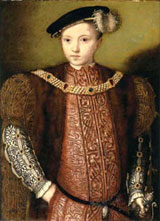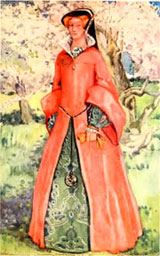Renaissance clothing - The Reigns of Edward VI and Mary Tudor
Renaissance Clothing Under Edward VI
Men’s Renaissance fashion evolved during the reign of Edward VI, despite its short duration. Following the king’s example, the flat cap became very popular. Edward always wore a flat cap, with the base ornamented with bands of jewels. Except for the laboring classes, the hood went out of fashion, and was replaced by the type of cap worn by the Beefeaters (Yeomen Warders) at the Tower of London.
It is the time of jerkin or jacket, doublet or coat, and hose, generally worn with trunks, which were puffed, short knickerbockers. The sleeves fit more closely to the arm, with less cuts and slashes. The materials are rich, but the ornament is simpler, as shown in the portrait of Edward by William Scrots.

Edward VI
The hugely broad-shouldered appearance was still in fashion. However, the collars of the overcoats or jackets were not so wide, and more of the puffed shoulder of the sleeve was visible. The collar became quite small, as shown in Holbein’s portrait of Edward at Windsor castle, and the puff in the shoulders were not so rotund. The doublet is basically unchanged. The collar of the shirt is evolving towards the ruff of later years. It was generally left untied, with the ornamental strings hanging. Shoes are still broad in the toe.
Regarding women’s fashion, the dress is showing a move towards simplicity. The folded, diamond shaped French hood has disappeared almost entirely. The female dresses are plain: a hood or cloth cap, with a border hanging round the neck, and a gown with a close collar and tight sleeves, with a small puff at the shoulders. A well known female cap of the period was “Mary’s cap”, named after the unfortunate Mary Queen of Scots, who used to wear it constantly. An open gown displayed the neck, which was covered by the partlet. The women are also wearing cloth hoods, rather baggy cap-like hoods, with a hanging piece behind.
The most notable change is the collar of the gown, which suddenly springs into existence. It is a high collar and very open in front, showing a piece of the under-dress. On this collar is sewn the partlet, and the embroidery is often detachable. Especially for men, the Renaissance tailor had to support the partlet with wires, giving a stiff appearance. This happened also in the women’s case, but generally the trend was towards simpler dresses with skirts less voluminous than before. Overcoats had hanging sleeves, the arm of the wearer coming out just below the puffed shoulder-piece.
Renaissance Clothing Under Mary I
Mary’s Spanish marriage with Philip brought the Spanish Renaissance fashion in the streets, leading to important changes in dress. The most notable is the high-peaked Spanish hat, made of velvet with a narrow brim, worn on one side of the head. There is also the hard-crowned hat. Round its crown-base is a gold cord clasped by a jewel, and sometimes a feather is stuck into the hat.

Renaissance Dress
Reign of Mary I
Now the ruff, very neat and small, became main stream, while the short cloak coexisted with the overcoats of Henry's and Edward's reigns. The cloak was cut in full folds, and reaching not far below the waist. Another model had a turned up high collar. A lot of men still preferred the flat cap. Older men had a coif tied under their chins, and over this the flat cap.
The shoes are now more to the shape of the foot. The boots were high, strapped up over the knee, or half-boots with the tops turned over to be seen. The doublets were shaped more closely to the body, transitioning to the Elizabethan costume. They still retained the long skirt to the doublet, and the opening to show the collar of the shirt, or partlet strip.
Ladies now show more hair, parted, as before, in the centre, but now puffed out at the sides. The gowns, though retaining the same appearance as before, full skirts, no trains, big sleeves, and split to show the under-gown, have the top part of the gown covering the bosom made of a separate material. For example, a gown of fine cloth will have collar and yoke of velvet.
With the head dress, the main fashion trend was towards neat linen caps, made plain and close to the head, with small ear-pieces. On the shoulders, the women wore kerchiefs of linen or silk, generally white. There was also the custom of carrying small posies of flowers.
With most dresses of this Renaissance period there was a great abundance of gold buttons, and the wearing of gold chains was common. Men wore a gold chain about the neck, while a gold chain girdle was a part of a woman’s everyday dress.
Men’s Renaissance clothing in the times of Henry VIII.
Women’s Renaissance clothing in the times of Henry VIII.
Elizabethan costume.
Renaissance clothing page.